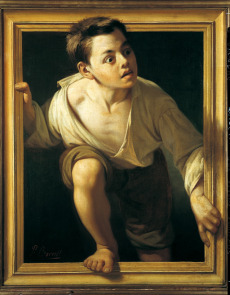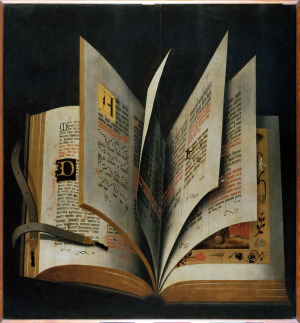Among the many reasons I wish I were in Italy right now is Art and Illusions: Masterpieces of Trompe-l’oeil From Antiquity To The Present, which is on view at the Palazzo Strozzi in  Florence until Jan. 24. (It started last month.) The poster picture (left) is a pretty good indication of why — doesn’t Pere Borrell Del Caso’s Escaping Criticism make you smile?
Florence until Jan. 24. (It started last month.) The poster picture (left) is a pretty good indication of why — doesn’t Pere Borrell Del Caso’s Escaping Criticism make you smile?
The show is reminiscent of the National Gallery of Art’s Deceptions and Illusions: Five Centuries of Trompe-l’Oeil Painting, which was on view in late 2002 and early 2003, and didn’t travel.
But the Palazzo Strozzi’s is larger: 200 works (vs. 116 at the NGA), including — the website describes it — “sculpture, intarsia, scagliola, pietre dure, porcelain, etc. Examples exhibited include faux armoirs, half-open, with books inside, wood intarsia of small Renaissance studios, scagliola tabletops and stones portraying seemingly prehensile objects, soup tureens and table furnishings in the shape of vegetables, anatomical and botanical wax models.”
 The exhibit also gives Europeans their first look at works by American artists specializing in trompe-l’Å“il — such as Peto, Kaye, Harnett and Haberle.
The exhibit also gives Europeans their first look at works by American artists specializing in trompe-l’Å“il — such as Peto, Kaye, Harnett and Haberle.
Bet Otis Kaye’s D’-jia-vu? (The Stock Market), at right, is a hit, as it usually is here when the market is causing pain. It was painted in 1937.
The show in Florence has ten sections, with titles like “Still Life or Trompe-l’Oeil?” “Paperwork” and “Figures Caught Between Real And Illusory Space.” Each is explained and illustrated on the website here.
The exhibit also has a scientific side.
This part is curated by Richard Gregory, a neuropsychologist who founded the first interactive scientific center in England. He has designed activities, especially for families, that explore illusions and why the human brain is fooled.
 The Palazzo Strozzi is getting to be a favorite of mine. Its last exhibition, Galileo: Images of the Universe From Antiquity to the Telescope, which I wrote about here last March, also united art and science. I also like it, from afar, because it stays open until 8 p.m. every night except Thursday, when it’s open until 11 p.m. (a model for others).
The Palazzo Strozzi is getting to be a favorite of mine. Its last exhibition, Galileo: Images of the Universe From Antiquity to the Telescope, which I wrote about here last March, also united art and science. I also like it, from afar, because it stays open until 8 p.m. every night except Thursday, when it’s open until 11 p.m. (a model for others).
And one last thing: The Palazzo Strozzi launched a series of books with the Galileo exhibit that focus on one single work — a “conversation.” This time, those in charge have chosen Kaye’s painting, which follows the market from about 1929 through 1937, when Kaye lost his own fortune. Lawrence Weschler (director of the New York Institute for the Humanities), Lorenzo Bini Smaghi (board member, European Central Bank), Mark Mitchell (curator of American paintings at the Philadelphia Museum of Art), JSG Boggs (a contemporary artist who focuses on money), and the painting’s owner will do the talking.
Which gives me an excuse to use a picture of a book that’s in the exhibit: Codice Miniato, Scuola tedesca.
Photos: Courtesy Palazzo Strozzi
